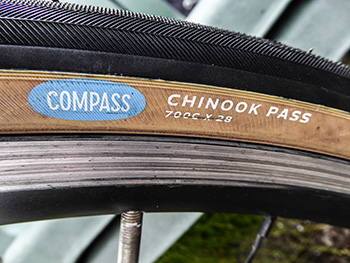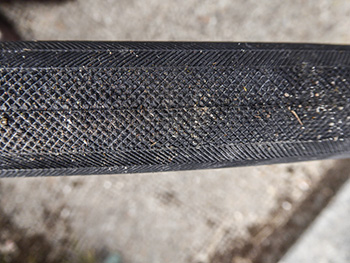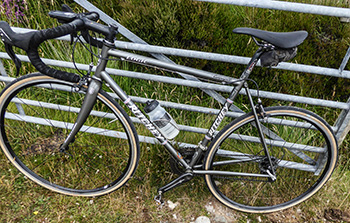
..........................................................................................................................................................................................................
compass 700 x 28c chinook pass tyres

i'd be the first one to admit that i'm undoubtedly guilty of jumping on the vintage bandwagon. when choosing remo drumheads to replace the stock dw heads on my vintage marine pearl drumset, i not altogether surprisingly opted for remo's vintage ambassadors, expressly created to recreate the original plastic head from the 1950s. the very chap that succeeded the calfskin heads used up until that point. though the majority of us have been hitting white, black or clear plastic ever since, i'm still amused to hear non-drummers continue to refer to the heads as skins.
however, one of the bands with which i play infrequently has a predilection for testing the legal limits on noise pollution, so much so, that for the last three or so years, i have used ear-plugs to stop me going deaf. and in order that i don't injure myself in the quest for matching volume, i have my drumset mic'd through the pa system, a fact in itself that doubtless adds to the forcefield of sound assailing the audience. however, beating the stuffing out of a hapless cherry-wood snare drum was always going to take its toll on the drumhead, in this case resulting in the wearing away of the rough white coating, added at the factory to aid a decent brush sound where necessary.
this gig is not one of of those necessary moments.
the problem then arose of what to replace the knackered drumhead with. just for the purposes of reference, when you've finished reading this, take a trip over to remo.com and note just how many variations there are on the humble drumhead, even confining oneself to the 14" size. the original head consists of a 10mm mylar film; the ambassador x that i ultimately chose was double that thickness. but from an aesthetic point of view, it's not the thickness that makes any difference, for the rough white coating seems every bit as expendable as it was on the previous outing.

and you thought that i just randomly hit stuff.
the very same problem (other than the hitting bit) can be experienced when time comes to purchase a set of tyres, price considerations notwithstanding. it's possible many riders have their favourite tyre brands, just as many tend to favour brands of componentry or bicycle frame. prices that now equate with those of car tyres might test some of those allegiances, but there's no doubt that there's still a bewildering number of options for the choosing of, made all the greater due to closer attentions being paid to width.
even in the professional peloton these days, 28mm no longer raises too many eyebrows, a width of tyre once more usually reserved for the annual blast across the cobbles to roubaix. happily, the frame manufacturers have kept their eyes wide open, though older bicycles may struggle to accept this wider and taller rubber. but there is then the matter of tread pattern and just how well you think those rubber designs will suit your style of riding and local terrain. sadly, much of the latter is just so much marketing. we generally don;t ride fast enough for it to make a lot of difference.
i spoke once to a tyre technician from one of the world's more prominent manufacturers, enquiring if it were possible to purchase a clincher featuring the tread pattern on their professional level tubulars. he told me that, while pro riders and mechanics were generally happy with whatever was provided by the tyre sponsor, the average consumer (that's you and me) likes to see squiggly bits on their rubber, preferably updated on a regular basis. happily, the fine folks at the panaracer made, compass tyres, seem not to have fallen for the aforementioned smoke and mirrors, offering their chinook pass clincher with a traditional file tread and (joy of joys) an amber sidewall.

for those of us eager to marry performance with style, that latter feature is of major importance.
the chinook pass variation (other widths are available, but with different names) is also tubeless compatible, but since the wheels to which i fitted them are not, i combined them with inner tubes. tubeless is fine, but i'm still not entirely convinced it will save the world. compass cycles display a commendable attachment to minimal packaging and the bags in which the pair arrived were hardly festooned with marketing claims or endless warranty booklets. that said, they were pretty darned hard to fit, resulting in sore thumbs for a day or two afterwards. however, i'm generally of the opinion that any difficulty in fitting, ought also to result in a reluctance to depart the wheel in the face of adversity.
personally, i can't see the point in fitting wider rubber and attempting to inflate it to the same pressure as would be common with a 25c tyre. where's the potential for improved comfort? therefore, i inflated the chinooks to 85psi (around 6 bar), a pressure which seems to agree with both them and i. however, according to the online instructions, when run in tubeless mode, the recommended pressure is 60psi (4.1 bar). the labelling on the sidewall attests to a maximum of 105psi, or 7.5 bar. i can testify to the safety of my choice of pressure when using inner tubes, having so far covered around 200km with no adverse effects.

though you may be aghast at the arrogance of presuming to review a pair of tyres after a mere couple of hundred kilometres, let me advise that this is simply my opening gambit; there will be more later. however, initial impressions are exceptionally good; it's not uncommon to fit new tyres and scarcely notice one way or the other. the chinooks offer a remarkable smoothness and grip, both in wet and dry conditions. i have no real fears that this situation will alter, though i expect the combination of caliper brake dust and rain to eventually discolour those delightful amber walls.
to be continued...
compass tyres are exclusively available in the uk from dorset's sven cycles. the standard version as reviewed are priced at £50 each, while the lightweight version costs £75 each.
monday 23 july 2018
 ..........................................................................................................................................................................................................
..........................................................................................................................................................................................................